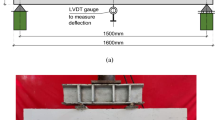Abstract
Reports on the very brittle and splitting mode, of failure of tension lap splices anchored in high strength concrete (HSC) specimens and the lower normalized bond stress\(\left( {{u \mathord{\left/ {\vphantom {u {\sqrt {f'_c } }}} \right. \kern-\nulldelimiterspace} {\sqrt {f'_c } }}} \right)\) for high strength than for normal strength concrete, instigated several research projects aiming at recommending mechanisms to provide confinement and ductility for bars or splices anchored in HSC. The state-of-the-art report of ACI Committee 363, ACI 363R-84, defines high strength concrete as concrete with compressive strength above 6,000 psi (41.4 MPa).
The main objective of the research reported in this paper was to assess the effect of transverse reinforcement on bond strength and ductility of the mode of failure of tension lap splices anchored in HSC beam specimens with nominal concrete compressive strength 55 MPa (8,000 psi), and to recommend a transverse reinforcement design requirement related to the ACI transverse reinforcement index Ktr.
To meet the objective fifteen full-scale HSC beam specimens were tested. No pozzolanic material such as silica fume or fly ash was added to achieve high strength to avoid any effect such material might impose, on structural behavior. Each beam was designed with bars spliced in a constant moment region at midspan. The variables used in the investigation were bar size, and the amount of transverse reinforcement placed in the splice region.
Résumé
Des travaux sur la rupture fragile causée par la fissuration de la longueur de recouvrement en tension des armatures d'un béton de haute résistance et la force d'adhérence normalisée\(\left( {{u \mathord{\left/ {\vphantom {u {\sqrt {f'_c } }}} \right. \kern-\nulldelimiterspace} {\sqrt {f'_c } }}} \right)\) inférieure pour le béton de haute résistance par rapport à celle du béton de résistance normale ont été à l'origine de plusieurs projets de recherches ayant pour objectif de recommander des mécanismes fournissant le confinement et d'augmenter la ductilité des armatures dans un béton de haute résistance. Un rapport récemment publié par le comité de l'ACI 363, ACI 363R-84, définit ce béton comme étant tout béton ayant une résistance à la compression supérieure à 6 000 psi (41,4 MPa).
L'objectif principal du programme de recherche ici présenté est d'évaluer l'effet des armatures transversales sur la force d'adhérence et la ductilité du type de rupture des longueurs de recouvrement en tension des armatures dans les poutres de béton de haute résistance ayant une force nominale de compression de 55 MPa (8 000 psi) et de conseiller une recommandation à suivre liée à l'index des armatures transversales Ktr.
Pour cela, quinze spécimens de poutres en béton de haute résistance ont été testés. Aucun matériau pouzzolanique comme la fumée de silice ou les cendres volantes n'a été ajouté au mélange permettant d'obtenir le béton de haute résistance afin de ne pas affecter le comportement structural du béton. Les poutres ont été étudiées de façon à ce que la zone de recouvrement des armatures soit au milieu de la poutre, où le moment est constant. Les variables utilisées dans cette recherche étaient le diamètre des armatures et la, quantité d'armatures transversales dans la zone de recouvrement.
Similar content being viewed by others
References
Azizinamini, A., Stark, M., Roller, J. J. and Ghosh, S. K., ‘Bond performance of reinforcing bars embedded in high strength concrete’,ACI Structural Journal 90 (5) (1993) 554–561.
Azizinamini, A., Pavel, R., Hatfield, E. and Ghosh, S. K., ‘Behavior of lap-spliced reinforcing bars embedded in high strength concrete’,ACI Structural Journal 96 (5) (1999) 826–835.
Azizinamini, A., Darwin, D., Eligehausen, R., Pavel, R. and Ghosh, S. K., ‘Proposed modifications to ACI 318-95 Tension Development and Isap Splice for High Strength Concrete’ACI Structural Journal 96 (6) (1999) 922–926.
ACI Committee 318, Building Code Requirements for Reinforced Concrete and Commentary (ACI-318-95/ACI-318R-95), American Concrete Institute, Farmington Hills, Michigan, 1995.
Hamad, B. S. and Itani, M. S., ‘Bond strength of reinforcement in high-performance concrete: The role of silica fume, casting position, and superplasticizer dosage’,ACI Materials Journal 95 (5) (1998) 499–511.
Hamad, B.S. and Machaka, M. F., ‘Effect of transverse reinforcement on bond of reinforcing, bars in silica fume concrete’,Mater. Struct. 32 (1999) 468–476.
Hamad, B. S. and Seferian, Z. S., ‘Role of casting position on bond of confined tension lap splices in silica fume concrete’,Mater. Struct. 33 (2000) 584–593.
ACI Committee 318, Building Code Requirements for Reinforced Concrete and Commentary (ACI-318-99/ACI-318R-99), American Concrete Institute, Farmington-Hills, Michigan, 1999.
Orangun, O. C., Jirsa, J. O. and Breen, J. E., ‘The strength of anchored bars: A reevaluation of test data on development length and splices’ACI Journal (March 1977) 114–122.
Author information
Authors and Affiliations
Rights and permissions
About this article
Cite this article
Hamad, B.S., Najjar, S. Evaluation of the role of transverse reinforcement in confining tension lap splices in high strength concrete. Mat. Struct. 35, 219–228 (2002). https://doi.org/10.1007/BF02533083
Received:
Accepted:
Issue Date:
DOI: https://doi.org/10.1007/BF02533083




